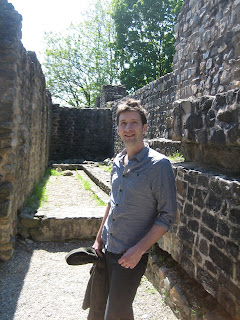Our first nigh in Lyon we ate at Le Petit Bouchon Chez George, one of the oldest school bouchons in town. It's very small, as the name states, and has only one server and one cook. I generally dislike taking photos in restaurants, but I am not against stealing photos from other sites:
These two photos combined show the whole room.
We sat exactly in the same spot, at the long communal table, with me in the photographer's position and Lia trapped in the middle of the banquette.
photos: http://www.itaste.com/list/restaurant/fr/lyon/au-petit-bouchon-chez-georges.html
While every tourist trap in town calls itself a bouchon, only about 15 of them are certified authentique.
The food was truly correct, in the French use of the term, meaning not fancy or perfect, but proper and right. We sat next to a group of two Lyonnais couples who were obviously well versed in the local dining traditions. The man to my right would pick out his favorite gratons (crispy pork skin covered in fat, served as a finger food to start the meal) from the communal dish and hand them to me to eat, exclaiming their specific virtues. He liked the extra-crispy ones. We ordered an asparagus salad, gâteau de foie de volaille (a light, quiche-like tart made with chicken livers), lamb chops with red wine and figs, and tablier de sapeur (literally "fireman's apron", in reality a square flap of breaded and fried tripe). We finished with the classic Lyonnais cheese, St-Marcellin.
The next morning we awoke not needing breakfast.
We decided that a walk up Fourvière hill would be beneficial to our health.
up down
Into the trees.
The view from the top.
At the top is the Notre Dame de Fourvière Basilica. It was built in the late 1800s, around the same time as Sacre Coeur in Paris. They both share a love of amazing stained glass, tile mosaics and gold, gold, gold. I didn't take any interior photos. I think I was just excited to get on to the Roman ruins.
A 5 minute walk from the basilica is this:
Fourvière was once a Roman settlement and there are many structures remaining, most notably the large theater (15AD) and the smaller odéon (2nd century) visible on the left.
top of the main theater
A narrow, stone-paved road ran behind the theater walls.
On the other side of the road was the town.
theater road town
Lia on the Roman road
in the remains of the town
the odéon from above
The original marble tiled floor of the orchestra area is still mostly intact.
Below is a little hint of what the walls would have looked like.
The brick would have been covered with a thick layer of plaster and then painted.
marble mosaics were used as decorative trim
portions of the theater support columns are still standing
there are several groupings of homeless remains
for Mr Mitchell, examples of Roman baseboard molding
Later that day, back down the hill, we checked out the remains of the Amphitheater of the Three Gauls. It was a popular place to make Christian martyrs, as the sign explains. Ste-Blandine was "hung on a post and exposed as bait for the wild animals that were let loose on her." Read all about it here.
For dinner we visited Le Bouchon de Filles, a newer bouchon run by two women who had previously worked at Café des Fédérations, one of the larger, more popular bouchons in town. Le Bouchon des Filles serves the old school food with a more modern, refined touch. Here is a great review, with more photos, in English: http://kitchen-notebook.blogspot.com/2007/11/le-bouchon-des-filles.html


























No comments:
Post a Comment